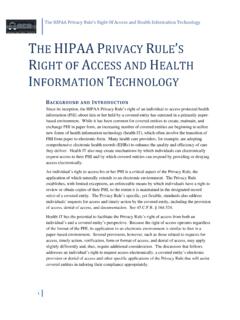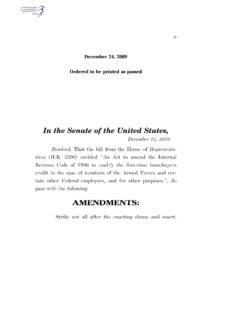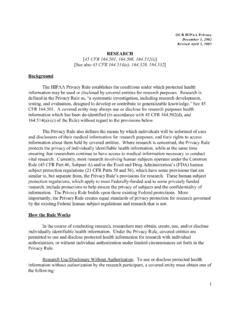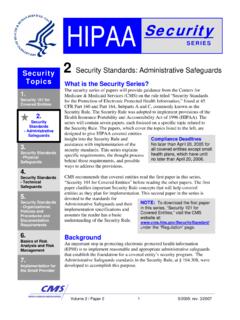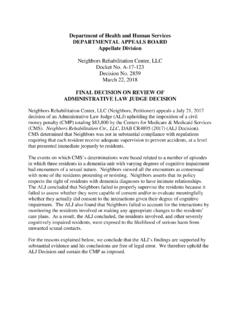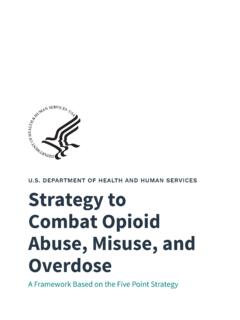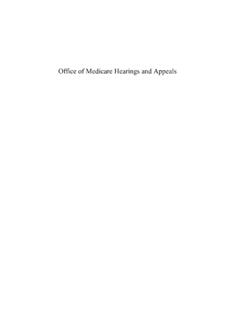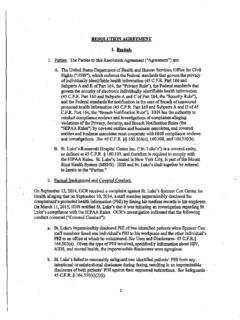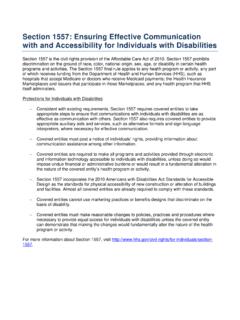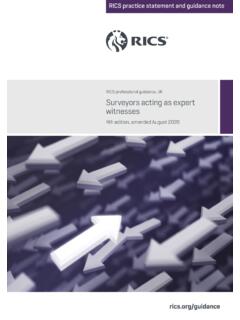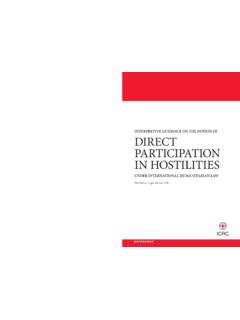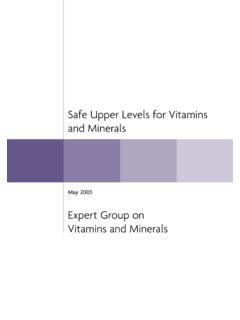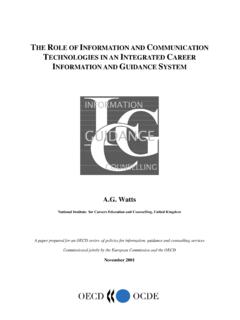Transcription of Guidance on De-identification of Protected Health Information
1 Guidance on De-identification of Protected Health Information November 26, 2012. 1 Guidance Regarding Methods for De-identification of Protected Health Information in Accordance with the Health Insurance Portability and Accountability Act (HIPAA) Privacy Rule November 26, 2012 OCR gratefully acknowledges the significant contributions made to the development of this Guidance by Bradley Malin, PhD, through both organizing the 2010 workshop and synthesizing the concepts and perspectives in the document itself. OCR also thanks the 2010 workshop panelists for generously providing their expertise and recommendations to the Department. Guidance on De-identification of Protected Health Information November 26, 2012. 2 Table of Contents 1. Overview .. 4 Protected Health Information .. 4 Covered Entities, Business Associates, and 5 De-identification and its Rationale .. 5 The De-identification Standard .. 6 Preparation for De-identification .
2 9 2. Guidance on Satisfying the Expert Determination Method .. 10 Have expert determinations been applied outside of the Health field? .. 10 Who is an expert? .. 10 What is an acceptable level of identification risk for an expert determination? .. 10 How long is an expert determination valid for a given data set? .. 11 Can an expert derive multiple solutions from the same data set for a recipient? .. 11 How do experts assess the risk of identification of Information ? .. 12 What are the approaches by which an expert assesses the risk that Health Information can be identified? .. 16 What are the approaches by which an expert mitigates the risk of identification of an individual in Health Information ? .. 18 Can an Expert determine a code derived from PHI is de-identified? .. 21 Must a covered entity use a data use agreement when sharing de-identified data to satisfy the Expert Determination Method? .. 22 3. Guidance on Satisfying the Safe Harbor Method.
3 23 When can ZIP codes be included in de-identified Information ? .. 23 May parts or derivatives of any of the listed identifiers be disclosed consistent with the Safe Harbor Method? .. 25 What are examples of dates that are not permitted according to the Safe Harbor Method? .. 25 Can dates associated with test measures for a patient be reported in accordance with Safe Harbor? .. 25 3. 5. What constitutes any other unique identifying number, characteristic, or code with respect to the Safe Harbor method of the Privacy Rule? .. 26 Guidance on De-identification of Protected Health Information November 26, 2012. 3 What is actual knowledge that the remaining Information could be used either alone or in combination with other Information to identify an individual who is a subject of the Information ? .. 27 If a covered entity knows of specific studies about methods to re-identify Health Information or use de-identified Health Information alone or in combination with other Information to identify an individual, does this necessarily mean a covered entity has actual knowledge under the Safe Harbor method?
4 28 3. 8. Must a covered entity suppress all personal names, such as physician names, from Health Information for it to be designated as de-identified? .. 28 Must a covered entity use a data use agreement when sharing de-identified data to satisfy the Safe Harbor Method? .. 29 Must a covered entity remove Protected Health Information from free text fields to satisfy the Safe Harbor Method? .. 29 4. Glossary .. 31 Guidance on De-identification of Protected Health Information November 26, 2012. 4 1. Overview This document provides Guidance about methods and approaches to achieve De-identification in accordance with the Health Insurance Portability and Accountability Act of 1996 (HIPAA) Privacy Rule. The Guidance explains and answers questions regarding the two methods that can be used to satisfy the Privacy Rule s De-identification standard: Expert Determination and Safe Harbor1. This Guidance is intended to assist covered entities to understand what is De-identification , the general process by which de-identified Information is created, and the options available for performing De-identification .
5 In developing this Guidance , the Office for Civil Rights (OCR) solicited input from stakeholders with practical, technical and policy experience in De-identification . OCR convened stakeholders at a workshop consisting of multiple panel sessions held March 8-9, 2010, in Washington, DC. Each panel addressed a specific topic related to the Privacy Rule s De-identification methodologies and policies. The workshop was open to the public and each panel was followed by a question and answer period. More Information about the workshop, including a summary, can be found at A webcast of the workshop can be viewed through streaming video from the website. Protected Health Information The HIPAA Privacy Rule protects most individually identifiable Health Information held or transmitted by a covered entity or its business associate, in any form or medium, whether electronic, on paper, or oral. The Privacy Rule calls this Information Protected Health Information (PHI).2 Protected Health Information is Information , including demographic Information , which relates to: the individual s past, present, or future physical or mental Health or condition, the provision of Health care to the individual, or the past, present, or future payment for the provision of Health care to the individual, and that identifies the individual or for which there is a reasonable basis to believe can be used to identify the individual.
6 Protected Health Information includes many common identifiers ( , name, address, birth date, Social Security Number) when they can be associated with the Health Information listed above. 1 The Health Information Technology for Economic and Clinical Health (HITECH) Act was enacted as part of the American Recovery and Reinvestment Act of 2009 (ARRA). Section 13424(c) of the HITECH Act requires the Secretary of HHS to issue Guidance on how best to implement the requirements for the De-identification of Health Information contained in the Privacy Rule. 2 Protected Health Information (PHI) is defined as individually identifiable Health Information transmitted or maintained by a covered entity or its business associates in any form or medium (45 CFR ). The definition exempts a small number of categories of individually identifiable Health Information , such as individually identifiable Health Information found in employment records held by a covered entity in its role as an employer.
7 Guidance on De-identification of Protected Health Information November 26, 2012. 5 For example, a medical record, laboratory report, or hospital bill would be PHI because each document would contain a patient s name and/or other identifying Information associated with the Health data content. By contrast, a Health plan report that only noted the average age of Health plan members was 45 years would not be PHI because that Information , although developed by aggregating Information from individual plan member records, does not identify any individual plan members and there is no reasonable basis to believe that it could be used to identify an individual. The relationship with Health Information is fundamental. Identifying Information alone, such as personal names, residential addresses, or phone numbers, would not necessarily be designated as PHI. For instance, if such Information was reported as part of a publicly accessible data source, such as a phone book, then this Information would not be PHI because it is not related to heath data (see above).
8 If such Information was listed with Health condition, Health care provision or payment data, such as an indication that the individual was treated at a certain clinic, then this Information would be PHI. Covered Entities, Business Associates, and PHI In general, the protections of the Privacy Rule apply to Information held by covered entities and their business associates. HIPAA defines a covered entity as 1) a Health care provider that conducts certain standard administrative and financial transactions in electronic form; 2) a Health care clearinghouse; or 3) a Health A business associate is a person or entity (other than a member of the covered entity s workforce) that performs certain functions or activities on behalf of, or provides certain services to, a covered entity that involve the use or disclosure of Protected Health Information . A covered entity may use a business associate to de-identify PHI on its behalf only to the extent such activity is authorized by their business associate agreement.
9 See the OCR website for detailed Information about the Privacy Rule and how it protects the privacy of Health Information . De-identification and its Rationale The increasing adoption of Health Information technologies in the United States accelerates their potential to facilitate beneficial studies that combine large, complex data sets from multiple sources. The process of De-identification , by which identifiers are removed from the Health Information , mitigates privacy risks to individuals and thereby supports the secondary use of data for comparative effectiveness studies, policy assessment, life sciences research, and other endeavors. 3 Detailed definitions and explanations of these covered entities and their varying types can be found in the Covered Entity Charts available through the OCR website, at Discussion of business associates can be found at Guidance on De-identification of Protected Health Information November 26, 2012.
10 6 The Privacy Rule was designed to protect individually identifiable Health Information through permitting only certain uses and disclosures of PHI provided by the Rule, or as authorized by the individual subject of the Information . However, in recognition of the potential utility of Health Information even when it is not individually identifiable, (d) of the Privacy Rule permits a covered entity or its business associate to create Information that is not individually identifiable by following the De-identification standard and implementation specifications in (a)-(b). These provisions allow the entity to use and disclose Information that neither identifies nor provides a reasonable basis to identify an As discussed below, the Privacy Rule provides two De-identification methods: 1) a formal determination by a qualified expert; or 2) the removal of specified individual identifiers as well as absence of actual knowledge by the covered entity that the remaining Information could be used alone or in combination with other Information to identify the individual.
